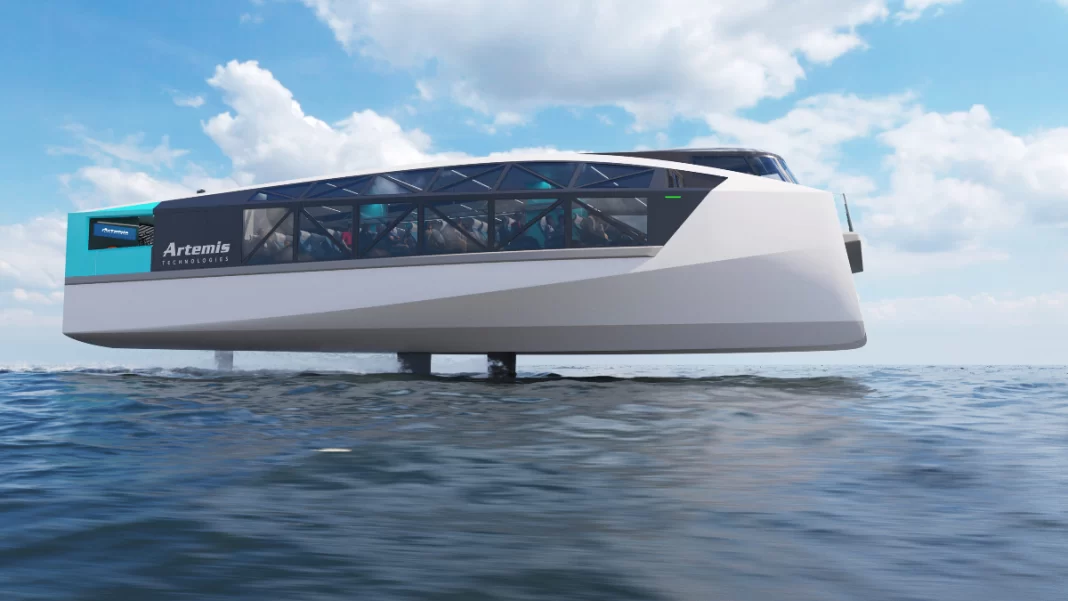The world’s first 100% electric high-speed foiling passenger ferry will be powered by renewable electricity supplied by Power NI, part of Energia Group.
Artemis Technologies and Power NI are partnering for Project Green Iron which will trial capturing green energy from an Energia Group wind farm in County Antrim to operate the Artemis EF-24 Passenger ferry’s Belfast to Bangor pilot scheme.
This innovative green energy pilot aims to maximise the use of renewable wind energy being generated in Northern Ireland by better matching times when there is low demand and high wind generation.
The pilot project is part of the work of the Belfast Maritime Consortium which was established to launch the world’s most advanced high-speed zero-emission passenger ferry and develop the technical and operational requirements for a maritime transport system of the future.
The consortium is led by Artemis Technologies and brings together 14 partners from across industry, academia and local government – including Northern Ireland’s largest electricity supplier Power NI. It is funded by UK Research and Innovation’s Strength in Places Fund.
The travel time along Belfast Lough for passengers on the electric foiling ferry, operated by Condor Ferries, will be around 25 minutes. This will reduce congestion, noise, and air pollution along the A2 route connecting both cities.
The pilot scheme will also showcase to the world what is possible with the right maritime infrastructure in place.
The Artemis EF-24 Passenger has been designed with the protection of the environment in mind. Its pioneering Artemis eFoiler® system allows it to fly above the waves producing no emissions in operation, offering a more comfortable ride for passengers and creating minimal wake to protect our shorelines.
Developing a green charging solution in collaboration with Power NI means the ferry can use 100% renewable electricity – another step forward on the global mission to decarbonise the maritime industry.
The name Project Green Iron stems from the term ‘cold ironing’ which relates to providing shoreside electrical power to ships berthed in a port when their engines are turned off. For diesel ships, this reduces the emissions they release in ports.
Project Green Iron takes vessel cold ironing to the next level. It will provide Power NI and Artemis Technologies with an innovative smart grid solution to vessel charging using 100% renewable electricity.
Renewable electricity generation is increasing and there are times when the energy generated exceeds demand. This can lead to situations where the grid has more electricity than it needs. This potentially causes instability issues if not managed properly.

Energia Group’s Corporate Development Manager, Gavin Hickey, said: “The wind farms are often forced to curtail – or turn down – how much energy they can generate because there isn’t enough demand from customers.
“This means Northern Ireland is unable to take full advantage of the available renewable electricity. Last year in Northern Ireland this lost opportunity came to over 130,000 MWh, which is enough electricity to power approximately 40,000 homes for a whole year.
“Project Green Iron seeks to take full advantage of Northern Ireland’s renewable electricity by creating flexibility in vessel charging patterns to shift recharging to align with times when there otherwise would be excess renewable energy and system curtailment.
“If we can increase demand at times when there is excess renewable energy, this will help in balancing the grid, contributes to grid stability, and reduces the need for fossil fuel-based backup power generation.
“We hope this demonstration scheme will prove the concept so that we can develop this further in other parts of the power system to ensure we’re making the most of the renewable electricity available to the system to decarbonise demand.”
To implement this new solution for the foiling ferry pilot scheme, Power NI will install smart meters and connected sensor devices at Energia Group’s Long Mountain Wind Farm in County Antrim and the Artemis Technologies charging depot in Belfast’s Titanic Quarter.
The two locations will be linked in the cloud to enable real-time simultaneous communication and control over electricity generation and demand.
When Long Mountain receives a signal to curtail its generation, the charger at Artemis Technologies can be turned on instead so that, in the future, the wind turbines can keep spinning. This process will ensure that the EF-24 Passenger is supplied with 100% renewable electricity and will reduce the carbon intensity of the local power grid.
Professor Katrina Thompson, Programme Director for the Belfast Maritime Consortium, said: “We are delighted to be working with Power NI on this project which will enable us to use 100% renewable energy to power our Artemis EF-24 foiling ferry.
“It’s so important to make the best use of the valuable energy created by the wind farms in Northern Ireland and for it not to be wasted.
“Through Belfast Maritime Consortium, close relationships have developed between a wide range of organisations who share a desire to decarbonise the maritime sector. Project Green Iron has evolved directly from this.
“Once this new scheme has been tried and tested, we hope to expand this technology out to areas of the world keen to operate zero emission vessels where there are difficulties connecting to the electricity grid. That is a very exciting prospect.”












